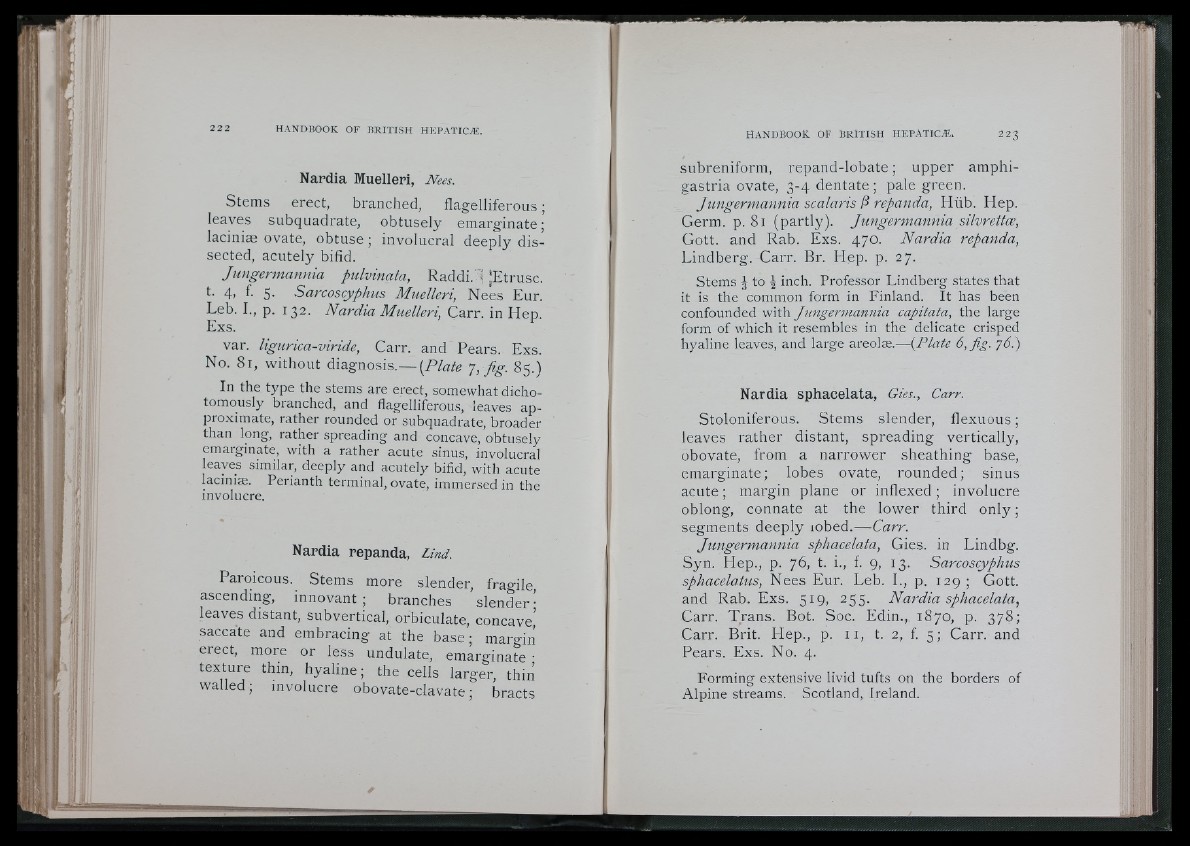
1 ■
i !'
^ i,
I. .
A Ï
Vi
Nardia Muelleri, Mes.
Stems erect, branched, flagelliferous ;
leaves subquadratc, obtu se ly emarginate;
laciniae ovate, obtuse ; involucral deeply dis sected,
a cutely bifid.
Jungermannia pulvinata, Raddi. 1 jEtrusc.
t. 4, f. 5. Sarcoscyphus Muelleri, Ne e s Eur.
Leb. I., p. 132. Nardia Muelleri, Carr, in Hep.
Exs.
var. lignrica-viride, Carr, and Pears. Exs.
No. 81, without diagnos is .— 1, fig- 85.)
In the type the stems are erect, somewhat dichotomously
branched, and flagelliferous, leaves approximate,
rather rounded or subquadrate, broader
than long, rather spreading and concave, obtusely
emarginate, with a rather acute sinus, involucral
leaves similar, deeply and acutely bifid, with acute
laciniæ. Perianth terminal, ovate, immersed in the
involucre.
Nardia repanda, Lind.
Paroicous. Stems more slender, fragile
ascending, in n o v an t ; branches s lender -
leaves distant, subvertical, orbiculate, conca ve’
saccate and embrac ing at the base • margin
erect, more or less undulate, emarg inate -
texture thin, hya l ine ; the cells larger, thin
wal led; involucre o b o v a te -c la v a te ; bracts
subreniform, repand-lobate ; upper amphigas
tr ia ovate, 3-4 denta te; pale green.
Jungermannia scalaris ß repanda. Hüb. Hep.
Germ. p. 81 (partly). Jungermannia silvrettoe,
Gott. and Rab. Exs. 470. Nardia repanda,
Lindbe rg. Carr. Br. Hep. p. 27.
Stems to 4 inch. Professor Lindberg states that
it is the common form in Finland. It has been
confounded with J ungermannia capitata, the large
form of which it resembles in the delicate crisped
hyaline leaves, and large areolæ.— {Plate 6, fig. 76.)
Nardia sphacelata, Gies., Carr.
Stoloniferous. Stems slender, f le x u o u s ;
leaves rather distant, spreading ver t ically,
obovate, from a nar rower sheathing base,
emarginate; lobes ovate, rounded; sinus
a c u t e ; margin plane or in f le x e d ; involucre
oblong, connate at the lowe r third o n l y ;
segments d e ep ly lobed.— Carr.
Jungermannia sphacelata, Gies. in Lindbg.
.Syn. Hep., p. 76, t. i., f. 9, 13. Sarcoscyphus
.sphacelatus, Nees Eur. Leb. I., p. 129 ; Gott.
and Rab. Exs. 519, 255. Nardia sphacelata,
Carr. Trans . Bot. Soc. Edin., 1870, p. 378;
Carr. Brit. Hep., p. 11, t. 2, f. 5; Carr, and
Pears. Exs. No. 4.
Forming extensive livid tufts on the borders of
Alpine streams. Scotland, Ireland.